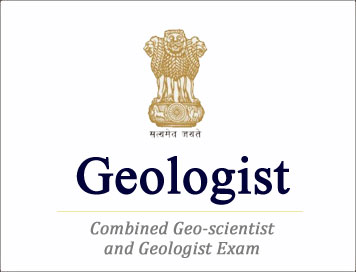(HOT) UPSC Current Affairs 2025 PDF
NEW! The Gist (NOV-2025) | E-BOOKS
UPSC Geo-Scientist and Geologist Exam Papers 2018 : Geo-Physics Paper - II

(Download) UPSC: Geologist Examination Papers-2018
Exam Name : UPSC Geo-Scientist and Geologist Exam 2018
Subject : Geophysics Paper - II
Year : 2018
GEOPHYSICS
Paper II
ITime Allowed : Three Hours
Maximum Marks : 200
QUESTION PAPER SPECIFIC INSTRUCTIONS
Please read each of the following instructions carefully before attempting questions.
There are TEN questions divided under TWO Sections.
Candidate has to attempt SIX questions in all.
Questions No. 1 and 6 are compulsory.
Out of the remaining EIGHT questions, FOUR questions are to be attempted choosing TWO from each Section.
The number of marks carried by a question / part is indicated against it.
Attempts of questions shall be counted in sequential order. Unless struck off, attempt of a question shall be counted even if attempted partly.
Any page or portion of the page left blank in the answer-book must be clearly struck off. Answers must be written in ENGLISH only.
Neat sketches may be drawn to illustrate answers, wherever required.
Unless otherwise mentioned, symbols and notations have their usual standard meanings. Assume suitable data, if necessary and indicate the same clearly.
Physical Constants
Electron rest mass, me = 9.109 x 10-31 kg
Proton rest mass, mp = 1.672x10-27 kg
Neutron rest mass, mn = 1.675 x 10-27 kg
Atomic mass unit (C12 = 12), a.m.u. = 1.661x10-27 kg
Bohr magneton, uB = 9.27x10-24 J/tesla
Nuclear magneton, uN = 5.05x10-27 J/tesla
Boltzmann constant, kB = 1.381x10-23 J/K
Speed of light in vacuum, c = 2.998 x 108 m/s
Electron charge, | e | = 1.602 x 10-19 C
Planck's constant, h = 6.626x10-34 J-s
Avogadro's number, NA = 6.023 x 1023 /mole
1 eV = 1.602 x 10-19 J
Mass of c14 = 14.003242 a.m.u.
Mass of Nl4 = 14.003074 a.m.u.
mp = 139.6 MeV/c2
mu = 105.7 MeV/c2
SECTION—A
1. (a) Define skin depth associated with the penetration of an
electromagnetic wave in the Earth. Determine the resistivity of the medium, if
an electromagnetic wave of frequency 40 Hz penetrates into the Earth up to a
depth of 1006 m. (Consider u = 4px 10-7
H/m)
(b) Define elevation correction in gravity prospecting. Determine the
elevation correction factor assuming the slab density p = 2.65 gm/cc.
(c) Show that the Laplace's equation for potential V holds good in an
isotropic homogeneous medium when a current of constant frequency (DC) or a very
low frequency AC flows in it.
(d) Write down the Wyllie's time-average equation. Compute the porosity
in a sandstone reservoir using the above equation considering the following
observations :
(i) An interval transit time in the sandstone reservoir was measured as 90
us/ft.
(ii) The acoustic velocity of the rock matrix was 18000 ft/s.
(iii) Fluid transit time was 189 us/ft.
(e) Define multiples. Distinguish between short-path and long-path multiples with the help of a schematic diagram for the case of horizontal beds.
2. (a) Explain the static shift phenomenon affecting the
magnetotelluric (MT) apparent resistivity data and discuss its effect on MT
impedance phase. Define the subsurface dimensionality as a function of MT
impedance tensor.
(b) Derive the expressions for potential and electric fields due to a
current dipole placed over a homogeneous ground at a distance r from the
measuring point.
3. (a) Explain the concept of 'zero-length spring'. Discuss the
principle of operation of astatic type of gravimeter.
(b) Draw a neat sketch explaining the elements of the Earth's magnetic
field. Express the magnetic potential V at any point on the surface of the Earth
in spherical coordinate system, signifying its internal and external origins.
4. (a) Show the positions of different detectors used in neutron
logging tool with respect to a neutron source, making suitable diagrams. Also
show the energy range for neutron-thermal neutron log and neutron-epithermal
neutron log on the drawing itself.
(b) From the given well log data, estimate the formation water
resistivity and water saturation :
Formation temperature = 150 °F
SSP = -32 mV
Rmf = 1.2 ohm-m at formation temperature
Rt = 3.5 ohm-m
Formation factor, F = 2
The ratio Rmfe/Rwe = 0.25
Multiplying factor for Rmfe = 0.85
Multiplying factor for Rw = 1:72
5. (a) Describe the methodology for common midpoint (CMP) or
roll-along shooting in seismic reflection survey with a suitable diagram.
(b) Derive the expression for estimation of depth of a horizontal
reflector using the intercept time and crossover distance methods in seismic
refraction with a suitable diagram.
SECTION-B
6. (a) Obtain a relation between spontaneous emission and stimulated
emission coefficients in lasers.
(b) A neutron breaks into a proton and an electron. Calculate the energy
produced in this reaction in MeV :
Mass of an electron = 9x10-31 kg
Mass of neutron = 1.675x10-27 kg
Mass of proton = 1.6725x10-27 kg
Speed of light = 2.998 x 108 m/s
(c) What do you mean by Poisson's equation? Convert this into
Laplace's equation.
(d) A diatomic molecule can be considered to be made of two masses m1
and m2 separated by a fixed distance r. Deduce a formula for the
distance of the centre of masses C from mass m. Also show that the moment of
inertia about an axis through C and perpendicular to r is ur2, where
u = m1/ m2 /(m1+ m2).
(e) A soap film of refractive index and of thickness 1.5x10-4
cm is illuminated by white light incident at an angle of 45°. The light
reflected by it is examined by spectroscope in which is found a dark band
corresponding to a wavelength of 5x10-5 cm. Calculate the order of
interference band.
7. (a) Briefly describe an X-ray spectrometer used in the study of
crystal structure.
(b) Write the principles of Mössbauer spectroscopy and discuss the effect
of magnetic field.
8. (a) Calculate (i) the fission rate of U235 for producing a power of
one watt and
(ii) the energy released in the complete fissioning of 1 kg of U235. Assume that
200 MeV is released per fission of the uranium nucleus.
(b) Find the specific heat at constant pressure of helium. If Cy = 3129
J/kg/K, one gram molecule of the gas occupies 22:42 litres at NTP. Given,
density of mercury = 13600 kg/m3.
9. (a) State Biot-Savart law and using that deduce an expression for
the magnetic field induction B due to a long current-carrying straight wire.
(b) What do you mean by scalar and vector potentials? Obtain gauge
transformations.
10. (a) Compute the mass m and speed v of an electron having kinetic
energy 1.5 MeV. Given, rest mass of an electron mo = 9.1x10-31 kgm, velocity of
light in vacuum c = 3 x 108 m/s.
(b) Obtain the derivation of Lagrange's equations from Hamiltonian
principle.
Click Here to Download PDF Geo-Physics Paper- II
<< Go Back To Main Page
Courtesy: UPSC

